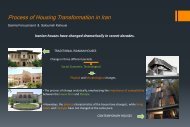Housing Concepts - Oikodomos
Housing Concepts - Oikodomos
Housing Concepts - Oikodomos
You also want an ePaper? Increase the reach of your titles
YUMPU automatically turns print PDFs into web optimized ePapers that Google loves.
OIKODOMOS <strong>Housing</strong> <strong>Concepts</strong><br />
MIXED-USE HOUSING<br />
Mixed-Use <strong>Housing</strong> Development, also been known as “Compact Development”, is not<br />
just a design/planning pattern that involves a multi-storey building whose ground<br />
floor is made up of commercial units and other floors having residential<br />
facilities; instead, it is a development that encompasses three or more<br />
significant revenue-producing and related land uses whose closeness of proximity<br />
shortens trips, lessens dependence on automobiles and encourages alternative<br />
modes of transportation such as walking, cycling and public transportation.<br />
Mixed-use development offers numerous benefits to its inhabitants. However, the<br />
most frequently stated benefits of this development pattern are sustainability<br />
and compliance with housing needs. Mixed-use may be developed at three scales,<br />
namely mixed-use buildings, mixed-use parcels/sites and mixed-use<br />
walkable/transit areas.<br />
Because housing is a very sensitive component of any town or city, the concept of<br />
mixed use seeks to rediscover the vitality and attractiveness of town centres;<br />
recognise the role of partnership in promoting affordable housing; and tackle the<br />
economic, environmental, social and political problems of providing liveable<br />
communities in contemporary cities.<br />
Beside all the advantages of mixed-use housing, the existence of a series of<br />
barriers, which are believed to prevent or inhibit the delivery of mixed-use<br />
development, remain a recurrent subject of discussion in the debate concerning<br />
mixed-use development. Barriers to mixed-use development have been seen<br />
differently by knowledgeable minds in this field of study, either as mere<br />
perceptions or reality.<br />
Typical examples of livable communities<br />
High automobile dependency: consequence of segregating<br />
related land uses.<br />
The adoption of mixeduse<br />
patterns can<br />
promote community<br />
living and improved<br />
access to services, as<br />
well as safety through<br />
the around-the-clock<br />
presence of people in<br />
the concept of 24-hour<br />
living.<br />
This pattern of housing<br />
development creates a<br />
variety of housing<br />
choices while reducing<br />
land wastage and<br />
automobile dependency.<br />
Communities developed<br />
using a single-use<br />
approach are often<br />
characterised by<br />
restricted movement and<br />
a reduced tax base.






